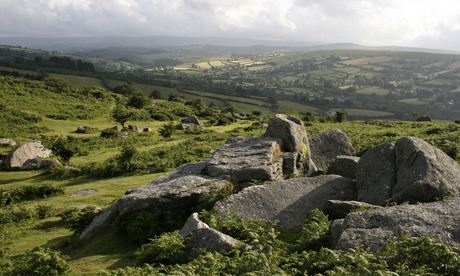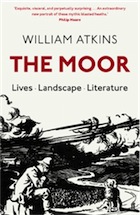Martin Hesp: Let's not have a pint in Yorkshire's Jamaica Inn | Western Morning News
... there is something very special about moorland, as a new book just out reminds us:
The Moor: Lives, Landscape, Literature – review
William Atkins's heady mix of topography, literary criticism and nature writing takes in Emily Brontë and Ian Brady, but is all the better for its resistance to the obvious

Dartmoor, seen from Bonehill Rocks in Devon. Photograph: David Lomax/Robert Harding/Rex Feature
Rough, wild, cruel and semi-savage: the early reviewers who used these words of Wuthering Heights were also thinking of the landscape in which the novel is set. In popular mythology, moors are a bogland, a badland, an undiscovered bourn from which travellers risk failing to return. The final image of Emily Brontë's novel is of three headstones.
Brontë didn't see the moors as dread and drear, though, nor its bogs as a slough of despond. Even the headstones are touched by beauty: moths flutter around them and a soft wind breathes through the heather and harebells. For every detractor of the moors, there is an enthusiast; for every scare story – "As you value your life or your reason, keep away from the moor," Sir Charles Baskerville is told in Conan Doyle's novel – a paean to their dark allure. Ted Hughes wrote of "the empty horror of the moor" but his poems celebrate its denizens' stubborn survival.
William Atkins's interest in moorland began at the age of 14, with a GCSE geography project. Outside Bishop's Waltham, the Hampshire town where his family had settled, lay a pale, rough, uncultivated stretch of ground, no bigger than a couple of football pitches. Locals called it the moors. In reality, it wasn't a moor but fenland: fens are low-lying and saturated from below, whereas moors are high and rained-on. Still, Atkins was hooked, and 20 years later he embarked on a journey, or series of walks, that took him from the southwest (Bodmin Moor, Dartmoor and Exmoor) via the Pennines (Saddleworth and Haworth) to Northumberland and the Scottish border.
His book is an ambitious mix of history, topography, literary criticism and nature writing, in the tradition of WG Sebald, Robert MacFarlane andOlivia Laing. Though not driven by a psychological or emotional crisis, it does have an element of personal quest. "I wasn't looking for an answer to some question of the heart," he says, "it was just that the 'moor' I'd known and studied as a boy had promised something that the meadow, the pasture and the woods had not – if not 'heroic adventures', then a kind of answer to the portion of myself that remained uncultivated. Victorian travellers knew the Sahara's deepest interior as désert absolu… I'd take myself off and find my own désert absolu, the wild blasted moor."
The Moor: Lives, Landscape, Literature – review | Books | The Guardian
The Moor, William Atkins
The Moor: Lives Landscape Literature: Amazon.co.uk: William Atkins: Books
Around the country, there have been several campaigns to protect our remaining moorlands:
Bog Squad To Protect Peatlands

Scottish peat bogs are set to receive a boost with the launch of a Butterfly Conservation Scotland ‘bog squad’ dedicated to saving these precious wildlife habitats.
The Bog Squad, was launched by Aileen Campbell MSP, at Langlands Moss Local Nature Reserve, East Kilbride, South Lanarkshire. The ‘Bog Squad’ team is a volunteer task force, created to carry out rehabilitation works on damaged peat bogs across the Scottish Central Belt, with funding from the Scottish Government’s Green Stimulus Peatland Restoration Programme.
Scottish peat bogs are key wildlife habitats providing homes for the bog specialists such as the, Large Heath and other rare butterflies such as the Small Pearl-bordered Fritillary, Green Hairstreak. Bog edges also provide vital homes for rare moths such as the Argent & Sable, Lunar Hornet and Wood Tiger.
Many Scottish bogs are in a poor state after being planted with alien conifers, damaged by drainage, used as dumps and stripped for garden use.
But they are increasingly valued for their biodiversity, and the 'ecosystem services' they provide, such as flood prevention and carbon storage.
Butterfly Conservation Bog Squad project Officer, Sara Green said: “Peatlands are not only beautiful and fascinating, they have their own unique wildlife. They also help us to reduce flooding and combat climate change by locking up carbon. We will be recruiting and training volunteers to help conserve these wonderful places.”
Butterfly Conservation - Bog Squad To Protect Peatlands
Even South-West Water are getting in on the act:
Increasingly we aim to work in partnership with our customers and communities... In other areas collaboration can lead to better, more sustainable solutions, rather than just being reliant on expensive engineering fixes to solve specific problems.
For example, on Exmoor and Dartmoor we’re working with our partners on total water catchment solutions. By restoring peat bogs on Exmoor a third less water now leaves the moorland during heavy rainfall compared with three years ago.
We cannot be complacent in battle for highest water quality | Western Morning News
There have been several campaigns in the media to encourage us to use alternatives to peat in the garden:
Do we need to use peat? - Telegraph
BBC - Gardening - Gardening Guides: Today in your garden - Ethical gardening
I Don’t Dig Peat – Join the Fight for Peat-Free Gardening – Garden Organic
But the pressures on peat moors are massive:
Peat extraction extension rejected for restoration
Permission has been denied to extend the period over which peat can be extracted from a site in Lanarkshire, with a reporter ruling that the land should be restored to mitigate climate change.
Various planning permissions had been granted for the workings, but peat extraction was due to cease this year. The appellants explained that core sampling indicated an average peat depth of three metres, providing more than 25 years' worth of additional extraction.
The reporter noted that peat is a source of carbon storage and emerging local policy sought to limit further extraction to avoid the release of carbon dioxide into the atmosphere. Although the site had been degraded by extraction, he judged it capable of being restored as active peat-forming bog that would assist in mitigating the impact of climate change.
That is: our peat bogs and moors are a massive store of carbon - and digging them up just exacerbates climate change:
Peat Soils vs. the Forests Above: Which Holds More Carbon?
May 9, 2014
Peat Soils vs. the Forests Above: Which Holds More Carbon? - The Equation
.
.
.






No comments:
Post a Comment